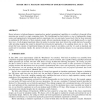Free Online Productivity Tools
i2Speak
i2Symbol
i2OCR
iTex2Img
iWeb2Print
iWeb2Shot
i2Type
iPdf2Split
iPdf2Merge
i2Bopomofo
i2Arabic
i2Style
i2Image
i2PDF
iLatex2Rtf
Sci2ools
98
Voted
WSC
2008
2008
Better than a petaflop: The power of efficient experimental design
Recent advances in high-performance computing have pushed computational capabilities to a petaflop (a thousand trillion operations per second) in a single computing cluster. This breakthrough has been hailed as a way to fundamentally change science and engineering by letting people perform experiments that were previously beyond reach. But for those interested in exploring the I/O behavior of their simulation model, efficient experimental design has a much higher payoff at a much lower cost. A well-designed experiment allows the analyst to examine many more factors than would otherwise be possible, while providing insights that cannot be gleaned from trial-and-error approaches or by sampling factors one at a time. We present the basic concepts of experimental design, the types of goals it can address, and why it is such an important and useful tool for simulation. Ideally, this tutorial will entice you to use experimental designs in your upcoming simulation studies.
Modeling And Simulation | Single Computing Cluster | Thousand Trillion | Upcoming Simulation Studies | WSC 2008 |
Related Content
| Added | 02 Oct 2010 |
| Updated | 02 Oct 2010 |
| Type | Conference |
| Year | 2008 |
| Where | WSC |
| Authors | Susan M. Sanchez |
Comments (0)

